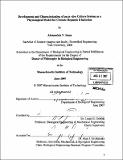Development and characterization of an in vitro culture system as a physiological model for chronic Hepatitis B infection
Author(s)
Sams, Alexandria V. (Alexandria Victoria)
DownloadFull printable version (46.58Mb)
Other Contributors
Massachusetts Institute of Technology. Biological Engineering Division.
Advisor
Linda G. Griffith.
Terms of use
Metadata
Show full item recordAbstract
Human Hepatitis B virus (HBV) is the prototype member of the family Hepadnaviridae that consists of enveloped, partially double stranded DNA viruses that specifically target hepatocytes for viral replication. Although a vaccine has been available for more than 20 years chronic HBV infection afflicts 350-400 million worldwide. It is estimated that 0.5-1.2 million people die each year from HBV-attributable cases of chronic hepatitis, cirrhosis, and hepatocellular carcinoma. Significant disadvantages exist among currently available therapeutics (e.g. IFNca, lamivudine, adefovir, etc.) that include limited efficacy and the promotion of drug-resistant viral strains. These therapeutics are the research products of the HBV molecular biology that can be manipulated in the laboratory setting. Future antiviral drug therapy is dependent upon the development of better cell culture systems that will allow the study of the complete viral life cycle. The use of primary human and primate hepatocytes is restricted by multiple experimental limitations including a rapid loss of susceptibility to infection in culture, lot-to-lot variability inherent in primary cell culture, and the necessity of treatment with chemical agents such as DMSO for reproducible infection. (cont.) Permissive cell lines are capable of supporting viral replication upon transfection with the HBV genome. These cell lines have helped to elucidate the later events in the viral life cycle. However, there is less understanding of the early stages that include virus attachment, internalization, uncoating, nuclear transport, and genome repair. Our group has developed an in vitro system that recreates many of the features of a perfused capillary bed structure. Various metrics (e.g. biochemical production, tissue morphology, liver-enriched mRNA expression, and drug metabolism) confirm that this system maintains a well-differentiated liver phenotype. Using DHBV as a surrogate model, this study has attempted to demonstrate that hepatocytes maintained in a more sophisticated culture system retain susceptibility to infection. This study has endeavored to establish the perfused three-dimensional culture system as potential tool to study early events of the viral life cycle. This research lays the foundation for the future development of a human HBV infection model in which early stages of the viral life cycle can be studied and therapeutic targets identified.
Description
Thesis (Ph. D.)--Massachusetts Institute of Technology, Biological Engineering Division, 2007. Includes bibliographical references (p. 152-164).
Date issued
2007Department
Massachusetts Institute of Technology. Department of Biological EngineeringPublisher
Massachusetts Institute of Technology
Keywords
Biological Engineering Division.